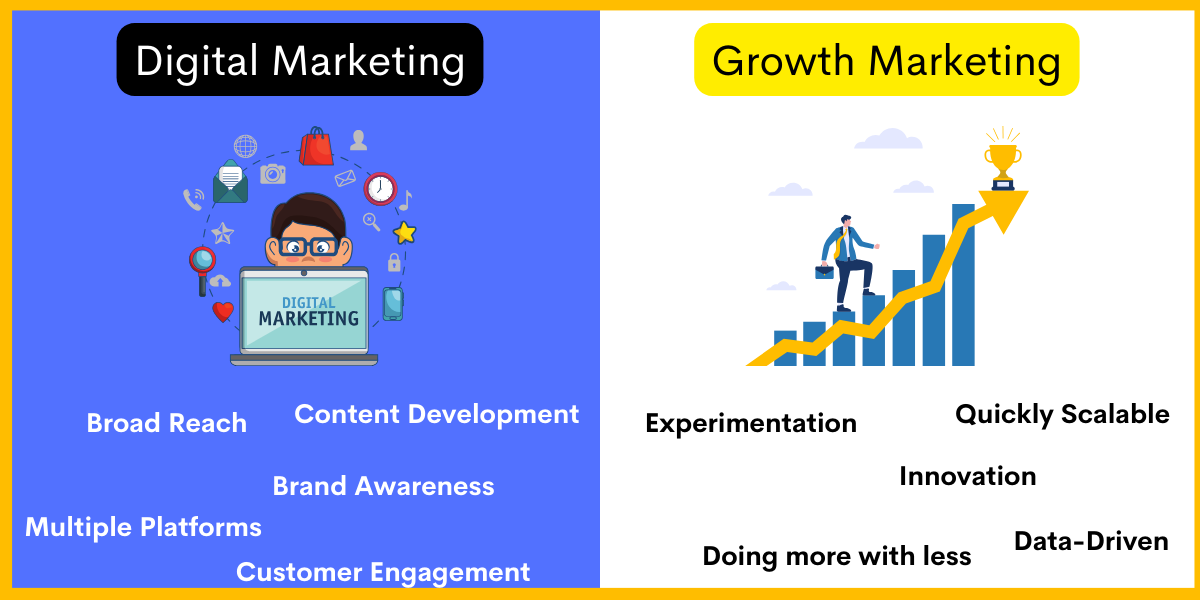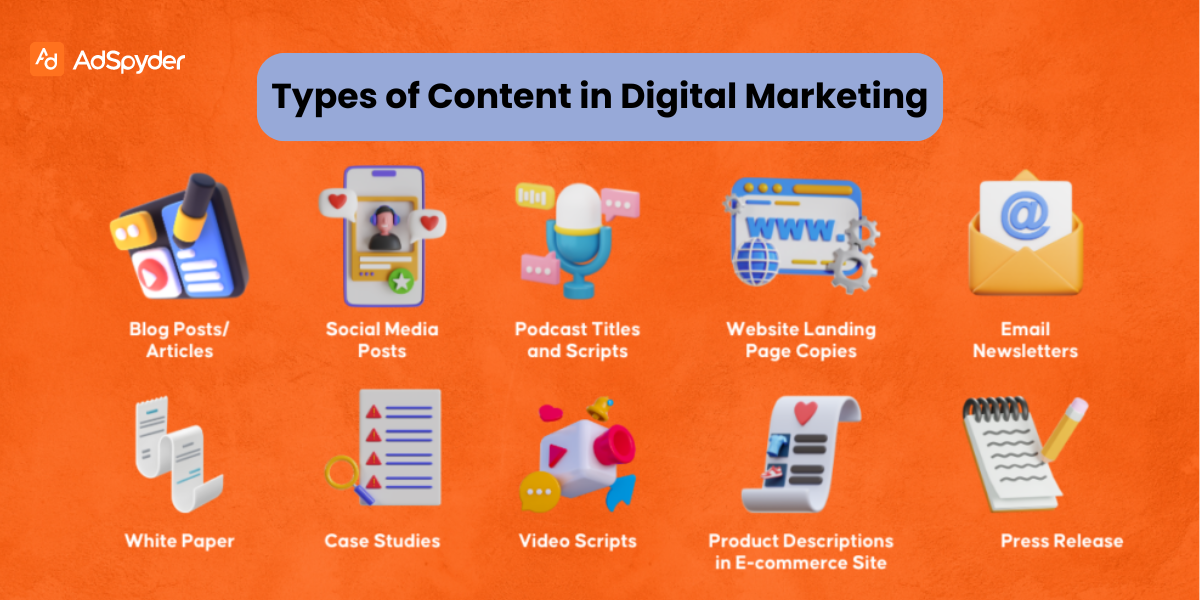Having trouble with your paid growth marketing strategies? Not anymore! Our guide has Ten top tips to improve your strategy and get better results. We go through everything from picking the right target audience to using digital tools.
Ready to Elevate your Marketing Strategy?
The Essentials of Paid Growth Marketing
Paid growth marketing uses online ads, search engine boosts, and social media to increase your brand’s visibility quickly. It combines creative ideas with data analysis to get people talking about your business.
Understanding Paid Growth Marketing startegies and Its Impact
Growth marketing uses online ads and content to boost a brand’s visibility. It focuses on long-term growth by analyzing marketing data. Tools like Google Ads and search engine optimization make businesses stand out online. Marketers design ads that increase website visits or sales. This marketing strategy examines the entire purchase process to spot improvement areas. Businesses test different strategies, like email campaigns or social media posts, to better connect with customers. The main goal is achieving sustainable growth by monitoring customer engagement, conversion rates, and return on investment closely.
The Intersection of Growth Hacking and Paid Strategies
Companies aim to grow quickly and keep succeeding for a long time. They track how many people sign up or buy after seeing an ad or social media post. This shows them which strategies really work. They combine creative ideas with targeted ads to attract more customers. Testing different website designs or ad messages helps find what attracts people the most. Tools like Google Analytics and CRM software give insights into customer behavior.
This strategy helps businesses expand fast without huge costs.
Crafting Effective Paid Growth Marketing Campaigns
To build effective paid growth marketing strategies, understand your audience’s needs. Analyze data from Google Analytics to create attention-grabbing ads that drive action.
Designing Campaigns for Maximum Impact
- Focus on knowing your audience well for effective paid growth marketing strategies. Market research tells you what they want and like. Use this info to create ads that speak to them.
- Adding search engine optimization (SEO) means more people searching for what you offer will see your ads.
- Aim for ads that don’t just get clicks but also lead to real sales.
- Make messages that strike a chord with viewers. Include a clear call-to-action (CTA) in each ad campaign, guiding customers on what to do next—like visiting a website, joining an email list, or buying something.
- A/B testing is key; it lets you tweak these CTAs based on actual feedback. Keep tabs on the best-performing versions to make future campaigns even better.
Innovative Tactics in Paid Growth Hacking
- Start growing fast by using referral marketing.
- Work with new brands and host events to draw people in. Scale up your startup quickly with these steps.
- Use data to guide your marketing moves. Check reports and keep an eye on key metrics and KPIs for growth.
- Customer relationship management systems and SEO tools are big helpers. They track what users do, bump up website traffic, and get more eyes on social media posts.
Digital Growth Marketing: Leveraging Online Platforms

Online platforms boost your marketing. They connect you with people and show how well your ads work, using real-time data.
Strategies for Social Media and Search Engines
For a strong social media marketing game, brands must make content that gets shared.
- Working with influencers boosts reach. Using paid ads on Facebook and Instagram is smart too.
- Knowing the audience helps create relatable content.
- On search engines, making websites Google-friendly is crucial. This involves choosing the right keywords for web pages and blog posts. Building backlinks from reputable sites improves trustworthiness in search engine eyes.
- Monitoring website analytics is key to tweak strategies effectively.
- Reviews and positive feedback boosts your presence in any platforms. Use social proof for marketing. This is especially true for ventures that require a sense of trust and authenticity, like online gambling sites.
Utilizing Digital Tools for Enhanced Campaigns
Digital tools greatly enhance marketing campaigns.
- Marketers use software to study data and track how customers act. This information helps them create targeted ads. They also adjust these ads based on feedback from customers.
- Platforms like social media make it easy to share and talk about content.
- Customer relationship management (CRM) systems boost communication and help build lasting relationships with customers.
- Email marketing tools let businesses send personalized messages that fit every stage of the customer journey.
With these technologies, companies see more brand loyalty and keep more customers.
Cross-Channel Integration for Maximum Impact
Cross-channel integration is essential for maximizing the effectiveness of paid growth marketing. By running synchronized campaigns across platforms like Google, Facebook, LinkedIn, and Instagram, brands can deliver consistent messaging and increase touchpoints with potential customers.
- Unified Messaging: Ensure consistent messaging across all channels, maintaining brand voice while tailoring content to fit the specific platform’s audience and format.
- Retargeting Across Channels: Use retargeting strategies to engage users who interacted with your ads on one platform across others. This reinforces brand awareness and increasing conversion chances.
- Data-Driven Optimization: Analyze performance data from each channel and optimize based on what works best for your audience. Some platforms may yield better conversion rates, while others drive more traffic.
- Coordinated Budgeting: Allocate budgets dynamically across channels depending on performance metrics like ROAS or engagement rates, ensuring maximum efficiency.
Cross-channel integration maximizes visibility and campaign effectiveness by combining the strengths of multiple platforms. By aligning messaging, retargeting, and optimizing data-driven insights, brands can deliver a cohesive marketing experience and boost overall impact.
Integrating Growth Hacking Strategies in Paid Campaigns
Using growth hacking and paid ads together speeds up success. Creative strategies and analyzing data work well for quick growth.
Creative Techniques for Rapid Growth
Mix growth hacking with paid advertising to grow your business fast.
- Use social media to catch people’s eyes with cool pictures and smart words. Build a community and share what users create to make your brand stand out without spending much.
- Make your ads match what people like. CRM systems track what customers do and prefer, so you can send them the right ads at the perfect time.
- For B2B space, examining the top LinkedIn ads can reveal effective strategies that brands can use to engage professionals. By showcase their offerings, they can drive conversions in a competitive B2B landscape.
- Landing pages are key—they’re like saying hi to potential clients online. A great landing page matches exactly what people want, making them more likely to buy from you. These simple steps help you win big in marketing.
Data-Driven Decision Making in Growth Marketing
In growth marketing, using data to make decisions is essential. We analyze numbers and trends from previous campaigns for our next steps.
Analyzing Growth Marketing Reports for Insights
Growth marketing reports show a lot about what customers do.
- These reports tell brands which content works and which doesn’t.
- Google Analytics is a tool that shows where visitors come from, how long they stay, and what they do on a website.
- This information helps make smart choices for growing a business.
- Next, focusing on key performance indicators (KPIs) is important for seeing success in paid campaigns.
Metrics and KPIs Essential for Paid Growth Campaigns
To understand growth marketing success, focus on key metrics and KPIs.
- These indicators show how revenue comes in and which strategies work best.
- Keep an eye on customer acquisition cost, return on investment (ROI), and conversion rates to see what’s effective. This approach helps make sure every dollar spent boosts sustainable business growth.
- KPIs guide the organization toward its goals by measuring success. Tracking user-generated content reveals customer satisfaction and brand engagement, keeping customers returning.
- Lifetime value shows the long-term profit each customer brings, encouraging approaches that keep customers around longer.
- By analyzing behaviors for website optimization, businesses can improve user experiences and increase conversions.
- Choosing the right KPIs aligns paid growth campaigns with company objectives while using resources effectively for a big impact.
Creating a Data-Driven Paid Strategy
A successful paid growth marketing strategy is built on data. It enables marketers to make informed decisions and optimize campaigns in real time. Having a data-driven approach is an emprical way of defining how your ad campaign should be optimised based on real data. Here’s how to implement a data-driven approach:
Set Clear KPIs
Define key performance indicators (KPIs) such as customer acquisition cost (CAC), return on ad spend (ROAS), and lifetime value (LTV).
- These metrics guide the overall strategy and help determine campaign effectiveness.
- Use tools like Google Analytics, Facebook Ads Manager, or AdSpyder to track performance. These platforms offer insights into user behavior, engagement rates, and conversion paths.
- It enables you to refine targeting and optimize bids. It is also useful for real-time tracking of data.
Segment Your Audience
Break down your audience into segments based on demographics, behaviors, and purchasing patterns.
- Create personalized ads for each segment, improving relevance and driving higher conversion rates.
- Personalised ad campaigns resonates withthe target audience and encourages them to perform the desired actions.
A/B Testing
The most important rule of digital marketing – testing, testing, testing.
- Continuously test different elements of your ads, such as headlines, CTAs, and visuals.
- Data from A/B testing helps identify which variations perform best, allowing you to scale successful campaigns and reduce wasted spend on underperforming elements.
Monitor Real-Time Data:
Use real-time analytics to adjust campaigns as they run.
- This flexibility allows for immediate tweaks to targeting, bidding, or creative elements, maximizing ad performance.
- Setup live notifications in your devices (mobile, app or email) notifying you of the important changes you need to track for better response from your end.
- Making the ad campaign better from these insights will help you maximise ROI on ads.
Optimize for Long-Term Value
Focus on strategies that increase customer lifetime value (LTV), not just immediate conversions.
- Use retargeting, email marketing, and loyalty programs to nurture leads and turn one-time buyers into repeat customers.
- The focus is to create loyal users who will also act as your brand heralds. Word-of-mouth marketing is possible if you have such loyal customers.
A data-driven paid strategy helps marketers optimize campaigns by aligning them with measurable goals. By leveraging real-time insights, segmenting audiences, and refining campaigns based on data, you can achieve higher ROI and sustainable growth.
Content Optimization for Growth Marketing

In content optimization, making web page words turn readers into customers is important. Use A/B testing to sharpen your message and get better results.
Crafting Content That Converts
- Start with your strengths to make engaging content. Solid content keeps readers interested and boosts sales.
- Use strong SEO skills to improve traffic on landing pages, blogs, and product descriptions. Knowing your audience’s background and preferences helps tailor messages they’ll love.
- Focus on branding to build a connection with customers. This bond turns them into loyal buyers.
- Content creation should highlight what makes your product special. Show how it solves problems or improves lives.
- Customer retention is key. Happy customers come back and bring friends.
- Influencer collaborations can spread the word fast. Choose influencers who match your brand’s vibe for authentic promotion.
- Every touchpoint matters – from ads to customer service talks. Make each interaction positive and memorable.
- Keep in mind the requirements of the industry while running ads. This can be in terms of platform or region specific restrictions. For example, responsible advertising in gambling industry is very much required, as these restrictions are stipulated platform wise and country wise
A/B Testing and Continuous Content Improvement
- A/B testing splits your audience to check different campaign versions. This way, you find out which one works better for higher engagement and conversion rates.
- By comparing two web pages or marketing assets, marketers learn what’s effective.This method increases sales and improves the user experience.
- After A/B testing, continuous content improvement is key.
- Marketers use test results to make their strategies better, making each campaign more successful than the last. They rely on data to make decisions, cutting ad costs while increasing impact.
- Every change in content comes from solid evidence.
Advanced Growth Hacking for SaaS Platforms

SaaS platforms grow fast by using A/B testing, SEO, and analytics tools. These methods offer insights at every touchpoint for quick scaling.
Unique Strategies for SaaS Growth Hacking
Experts reveal ways to attract more app users. They say success comes from trying new strategies, checking outcomes, and repeating the process. This method helps find the best approach.
For SaaS companies, combining paid ads with cost-free methods can boost growth quickly. Using digital tools lets them understand customer needs at every touchpoint better. Also, making content that meets user needs is essential. Analyzing data allows for adjusting tactics efficiently, saving time and money.
Scaling Up: Expanding Your Growth Marketing Efforts
To grow your business, increase your marketing efforts and find new customers. Get ready for useful tips to boost your growth marketing strategy using touchpoints!
Budgeting and Resource Allocation for Scaling
Growing your marketing needs careful budgeting and resource management. Plan your spending wisely, focusing on what brings in the most customers. For instance, if social media ads work well, put more money into them.
Use data to make informed decisions. Data shows which strategies have the best return on investment (ROI). It helps pick the right channels for your budget. This way, every dollar promotes high-impact growth activities and cuts waste.
Identifying and Targeting New Market Segments
To grow your business, focus on finding new customer groups.
- Start by understanding who they are.
- Look at their age, interests, and behavior.
- Use tools like surveys and social media analytics for clear insights.
Next, craft messages that connect with them directly.
- Digital ads and email marketing work well for this.
- Show how your product meets their unique needs. Effective segmentation targets the best prospects for growth.
- This ensures your marketing efforts reach the right people at the right time.
- Avoid misleading ads for your brands. This causes negative response to your brand and can be difficult to recover from. For example, the rise of misleading gambling ads poses significant challenges for regulatory bodies.
- These advertisements often exploit vulnerable audiences and can lead to harmful behaviors and financial distress. It can attract fines, legal actions and negative reputation for the brand.
Staying Ahead: The Future of Paid Growth Marketing Strategies
Try new methods and tech to improve your paid growth marketing strategies.
Emerging Trends in Digital and Growth Marketing
Digital marketing is quickly evolving. New technology impacts how companies connect with customers online. To stay competitive, businesses must adapt to these changes.
- Voice search and artificial intelligence are key tools in understanding customer needs.
- Interactive content stands out more than simple text or images. It makes people pay more attention.
- Marketers are using virtual reality and augmented reality to create memorable experiences for their customers.
Keeping up with these advancements is crucial for growing a business’s online visibility.
Preparing for the Evolving Digital Marketing Landscape
The digital marketing world changes quickly. Keep learning to stay on top.
- Learn about new tools like Google Analytics and SEO strategies. This helps understand your audience and improve your marketing.
- Listen to your audience too. Their feedback shows what works and what doesn’t. This lets you change strategies fast, staying relevant online.
- Trying new methods brings innovation and sets you apart from others.
- Talk with people in the industry for new ideas and tips. This builds a culture of growth and adaptability.
Conclusion
These ten tips will truly change your paid growth marketing. Use data to make smart choices and keep your content fresh and engaging. Tools like social media ads and search engine optimization are key. Always aim for campaigns that grab attention and spark interest. Expect to see real growth in your marketing results.




